New Additions to the Art Collection
A collection of new art has been added throughout the Club.
For inquiries about the art collection, contact Curator Mary Saunders at msaunders@hcny.com.
Main Dining Room
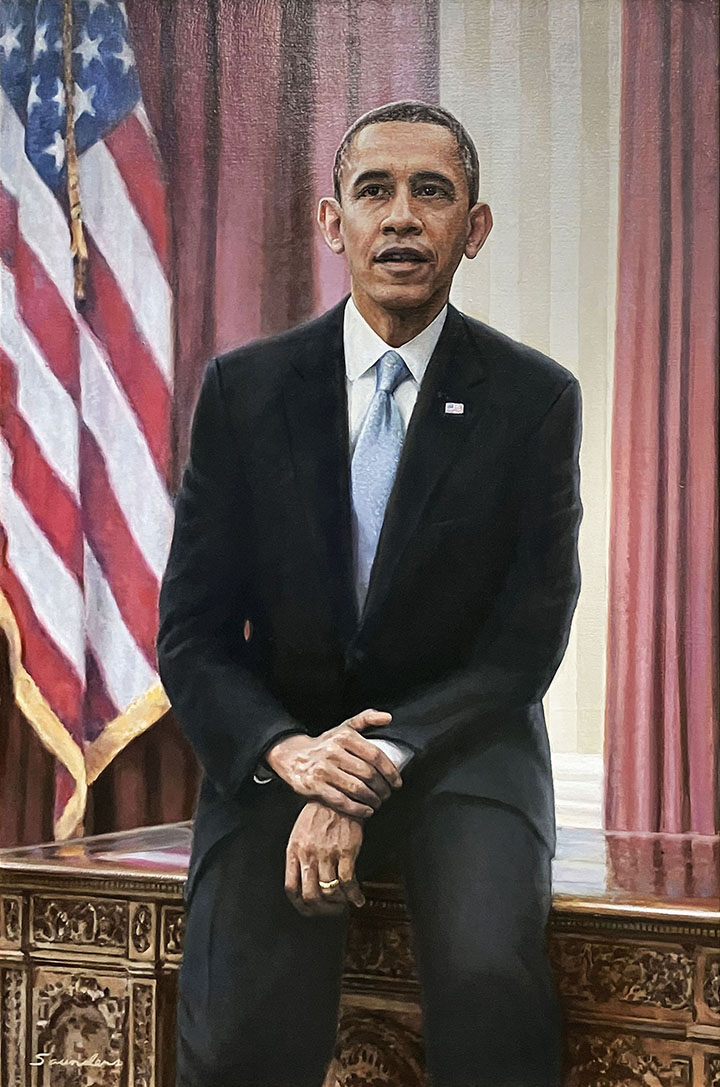
Barack Obama L’ 1991
Forty-fourth President of the United States
Barack Obama was born in Honolulu in 1961 and raised in Hawaii and Indonesia. He attended Occidental College in Los Angeles for two years before transferring to Columbia University where he earned a BA in political science in 1983. He entered Harvard Law in 1988 where he was the first Black president of the Harvard Law Review, attracting national attention. Law professor Laurence Tribe has stated that Obama was “an incandescent intellectual, who was much more articulate than almost any student I have had in over 40 years.” After graduating magna cum laude, he worked as a community organizer in Chicago and then ran for public office. In 1992 he married Michelle Robinson L’ 1988. In 1996 he was elected to the Illinois State Senate and in 2004 to the U.S. Senate. In 2008 he became the first Black American to be elected President of the United States. During his first term he signed three signature bills: The Recovery Act, the Affordable Care Act, and the Wall Street Reform Act. He was re-elected in 2012 for a second term.
Obama is a best-selling author of several books and continues in public service, remaining active in Democratic politics.
David Saunders (b. 1954)
A native New Yorker, Saunders began his artistic studies at the High School of Music & Art. He graduated from the Kansas City Art Institute in 1975 and afterwards exhibited in New York City art galleries in several solo shows. His first one-man museum show was in 1979 at the New Museum: his works are in the collections of the Metropolitan Museum of Art and the Museum of Modern Art, among others. He has taught at Yale, Oberlin, and Washington University. In 1987 Mayor Ed Koch presented Saunders with NYC’s Award For Excellence in Design. He also painted the Club’s portraits of Michelle Obama, Ketanji Brown Jackson, and I.M. Pei.
Oil on canvas, 2023
Main Dining Room
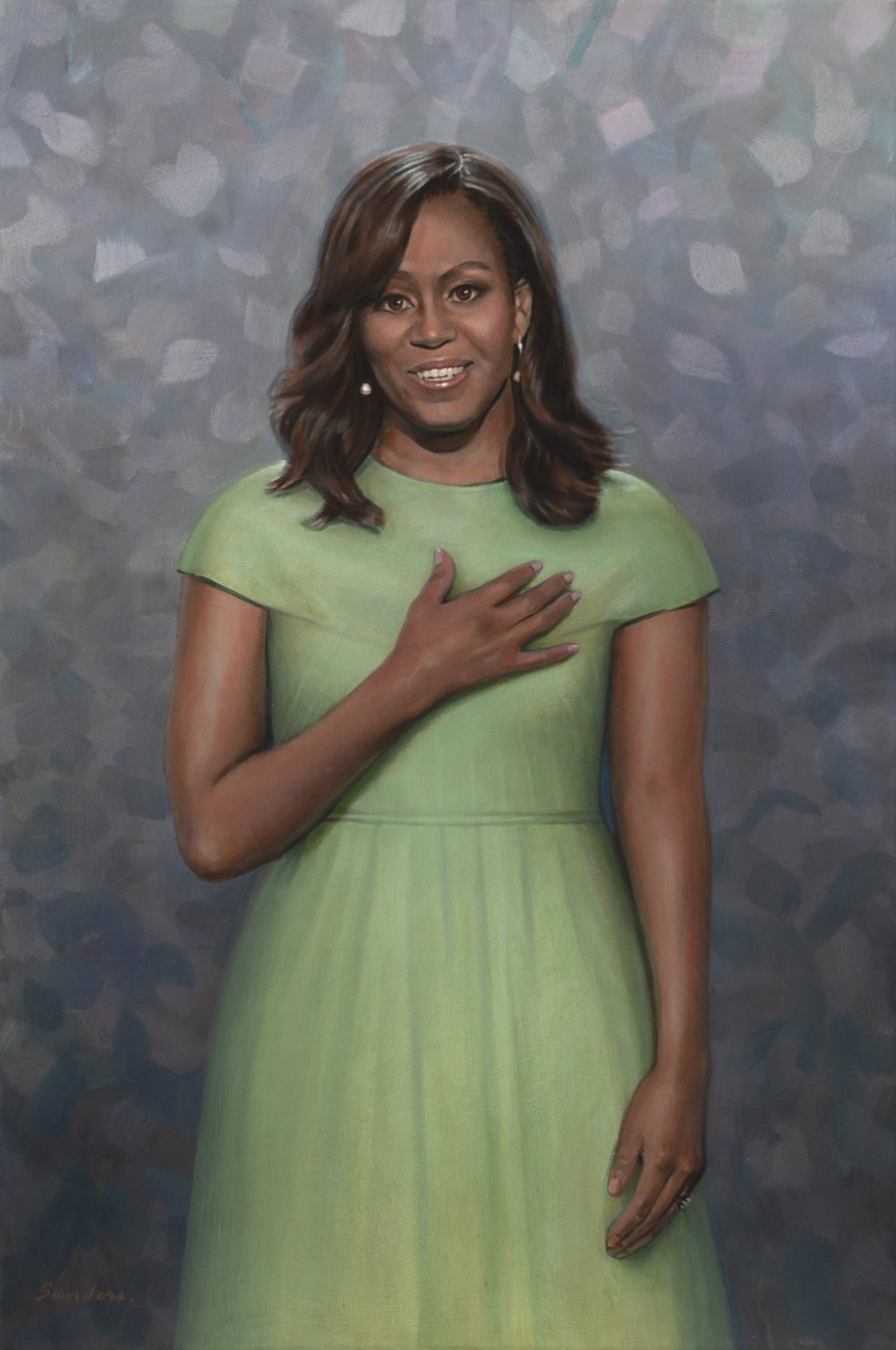
Michelle Obama L’1988
First Lady of the United States 2009-2017
Michelle Robinson Obama was born in Chicago, Illinois in 1964. She graduated cum laude from Princeton University in 1985, and from Harvard Law School in 1988, after which she returned to Chicago where she pursued a career in public service. There she met Barack Obama L’1991 and they married in 1992. When he was elected to the Presidency in 2008, they moved to the White House with two young daughters. She served as first lady for eight years and initiated health programs for young people and education for girls around the world. She continues her efforts to support and inspire young people, writing books, and speaking frequently all over the world.
David Saunders (b.1954)
A native New Yorker, Saunders studied at the H.S. of Music & Art. He graduated from the Kansas City Art Institute in 1975 and afterwards exhibited in NYC art galleries in various solo shows. His first one-man museum show was in 1979 at the New Museum. His works are in the collections of the Metropolitan Museum of Art and the Museum of Modern Art among others. He has taught at Yale, Oberlin, and Washington University. In 1987 Mayor Ed Koch presented Saunders with NYC’s Award For Excellence in Design. The artist’s wife, Mary Saunders is curator of the HCNY and it is in her honor that this painting has been donated to the Club.
Oil on canvas, 2022
Main Dining Room
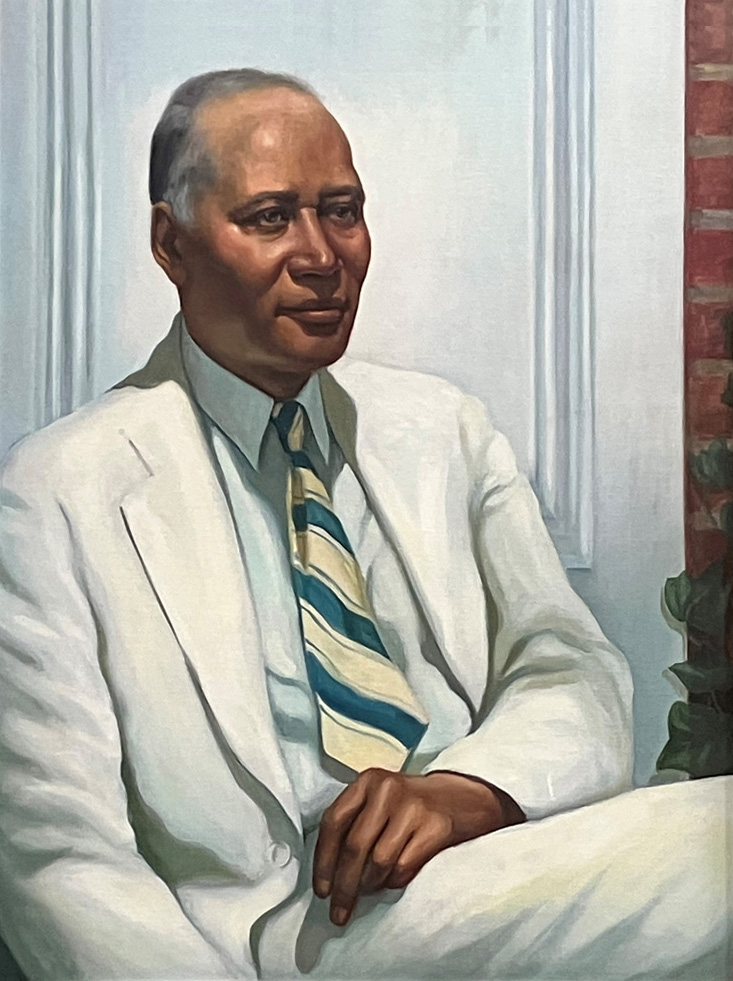
Charles Hamilton Houston L’1922, SJD’ 1923
Lawyer, educator, civil rights activist
Charles Hamilton Houston was born in 1895 in Washington, D.C., and graduated magna cum laude from Amherst College in 1915, where he delivered the valedictory address. In 1917, during World War I, he joined the army and was deployed to France. His experience of racism in the Army inspired him to study law: “I made up my mind that I would never get caught again without knowing something about my rights… I would study law and use my time fighting for men who could not strike back.”
Upon returning to the United States after the War, Houston entered Harvard Law School and was the first Black student to serve on the Harvard Law Review. He was mentored by future Supreme Court Justice Felix Frankfurter L’1906 and received both his LL.B. and D.J.S. from Harvard.
Five years later, he was recruited to serve as a professor and eventually dean of Howard University School of Law. He personally mentored an entire generation of Black lawyers, among whom was Thurgood Marshall, and the legal brilliance he used to undercut the “separate but equal” principle earned him the title “The Man Who Killed Jim Crow.” He worked tirelessly as general counsel for the NAACP, and although he died in 1950, he is considered the chief architect of the legal strategy that led to the landmark Brown v. Board of Education in 1954.
Betsy Graves Reyneau (1888-1964)
Born in Battle Creek, Michigan, Betsy Graves studied painting at the School of the Boston Museum of Fine Art. She became a political activist early on, protesting wages of dockworkers in Boston, and in 1917 was the first woman arrested for protesting President Wilson’s anti-suffrage stance. She lived in Europe from 1926-1939 where she gave refuge to Jews suffering from persecution under the Nazis. Upon her return to the United States, she was shocked by the injustices endured by Black Americans. A dedicated civil rights activist, she is best known for a series of portraits of prominent Black Americans, commissioned by the Harmon Foundation, which toured the United States from 1944 to 1954. The series includes portraits of George Washington Carver, Marian Anderson, Martin Luther King, Jr., and Paul Robeson. Many of these paintings, including this one of Houston, are now in the National Portrait Gallery, Smithsonian Institution, Washington, D.C.
Oil on canvas, 1943-44
HCNY copy courtesy of the artist’s estate
Main Dining Room
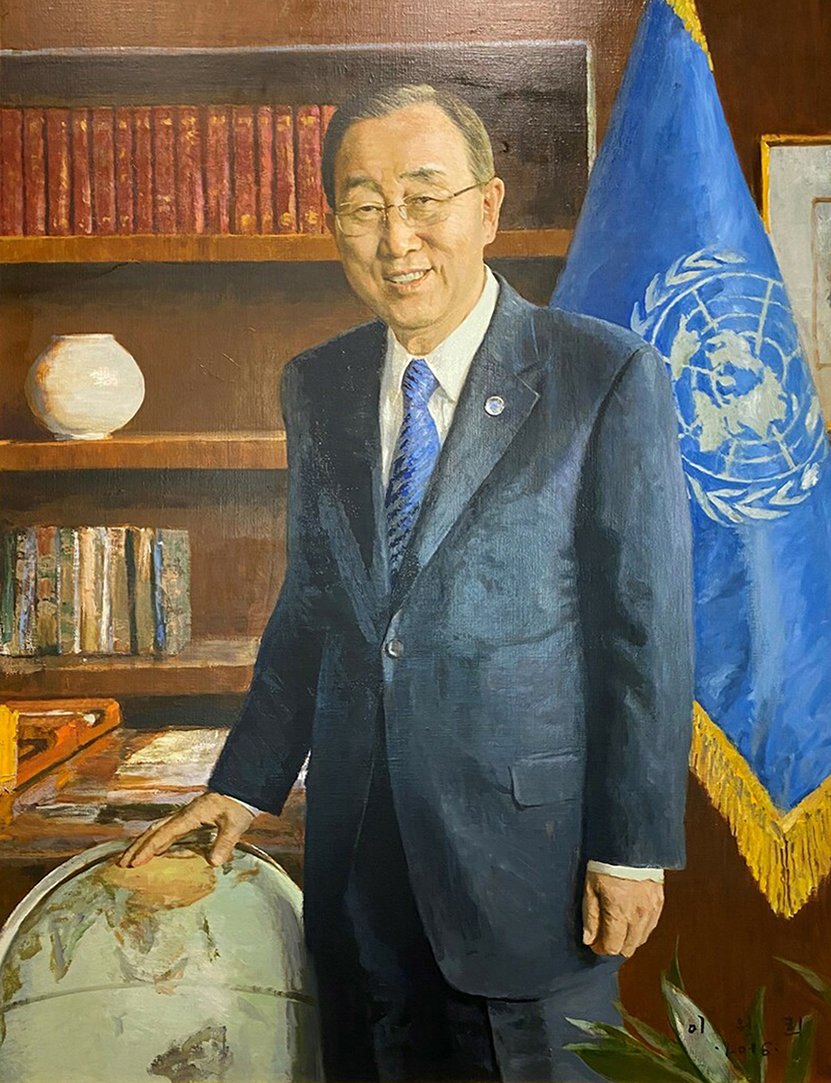
Ban Ki-moon MPA’1984
Secretary General of the United Nations 2007-2016
Ban Ki-moon was born in 1944 in a small farming village in what was then Japanese Korea. A star student through high school, he took his bachelor’s degree in 1970 in international relations from Seoul National University, and earned a master’s degree in public administration from the Kennedy School of Government, Harvard in 1984.
His career as a public administrator began in the Korean Ministry of Foreign Affairs; he served in that Ministry for 37 years. His posts included New Delhi, Washington D.C. and Vienna. In 1975 Mr. Ban was sent to the United Nations in New York and was elected Secretary-General in 2007, succeeding Kofi Annan. The major initiatives taken during his tenure were the Climate Change Summit, the creation of UN Women, and New Horizons, an international peacekeeping effort. He left office in 2016 and was succeeded by António Guterres.
Mr. Ban has since served on many organizations promoting support of environmentally sustainable and socially inclusive economic growth.
Lee Won-hee (b. 1956)
Le Won-hee was born in Hayang, Korea, studied at the Keimyung University, and received his BA in 1979 and MFA in 1985 from that institution. He has had over thirty solo exhibitions in museums and galleries in Korea and taken many prizes for his work. His portrait of Ban Ki-moon was unveiled at the United Nations Headquarters in December 2016. In his remarks at that time, Mr. Ban said to the artist, “You have depicted me in my office, the place from which I have sought to serve the world’s people for the past decade. You have posed me with my hand resting on our one and only planet—starting with my home continent of Asia. And I am wearing a UN blue tie—reflecting the banner of hope I first saw as a young child.
Oil on canvas, 2016
HCNY copy courtesy of the artist
Main Dining Room
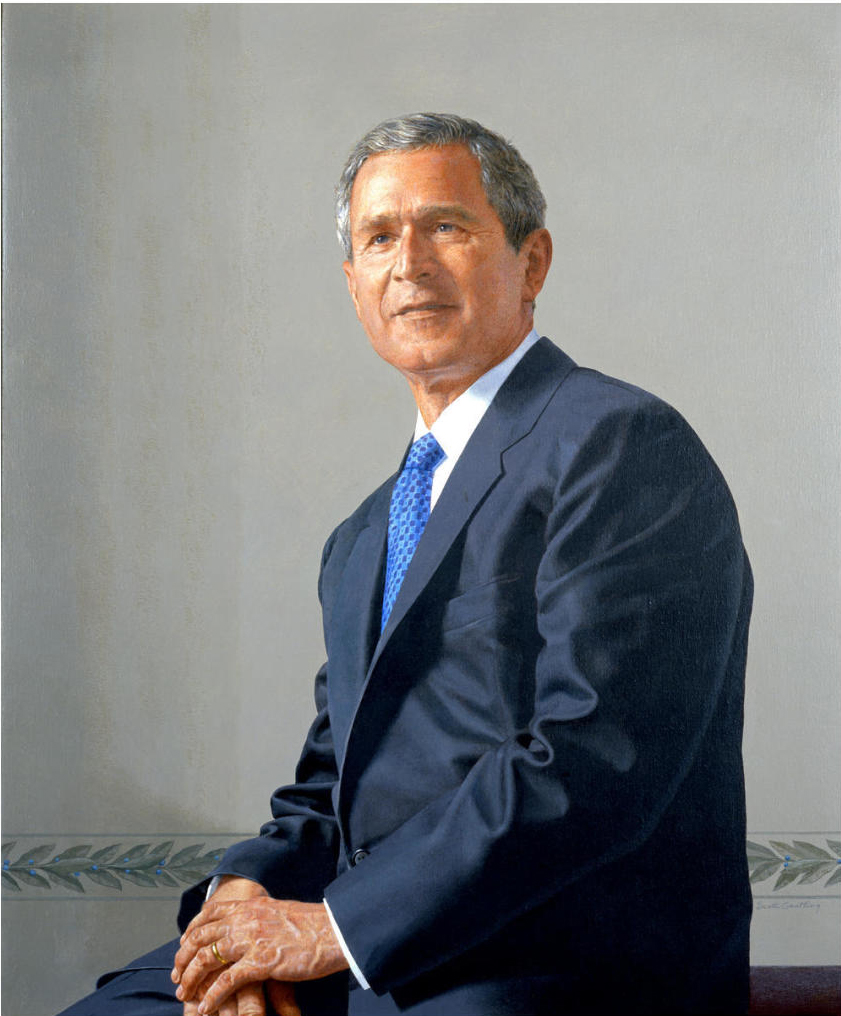
George W. Bush B’1975
Forty-third President of the United States
George Bush was born in 1946 in New Haven, Connecticut. He grew up in Midland and Houston, Texas. He received a BA in history from Yale in 1968, and then served as an F-102 fighter pilot in the Texas Air National Guard. He received a Master of Business Administration from Harvard Business School in 1975.
Bush was elected Governor of Texas in 1994 and 1998. When he was elected President of the United States in 2000, he followed his father, George H.W. Bush (President 1989-1993) into the White House. This was the second father–son pair to serve as the nation’s president. The first pair was two other Harvard graduates, the second president John Adams C’ 1755 and his son, the sixth president, John Quincy Adams C’1787. Bush was re-elected in 2004 for a second term.
In his autobiography, “A Charge to Keep,” Bush mentioned his time at Harvard as, “a turning point for me,” that taught “the principles of capital, how it is accumulated, spent, managed.” He was the first president with a master’s degree in business.
Scott Gentling (1942-2011)
Gentling was born in Rochester, Minnesota and moved to Fort Worth, Texas at age five. He studied art at the Pennsylvania Academy of Fine Art in Philadelphia and afterwards returned to Fort Worth, where he spent the rest of his life. His talent for portraiture led to many commissions including this one of George W. Bush, which he painted for the Texas State Capitol, after Bush’s term as Governor. Gentling is known for his artistic collaborations with his fraternal twin, Stuart Gentling, including their book Of Birds and Texas.
Oil on canvas, 2001
HCNY copy courtesy Texas State Capitol
Main Dining Room
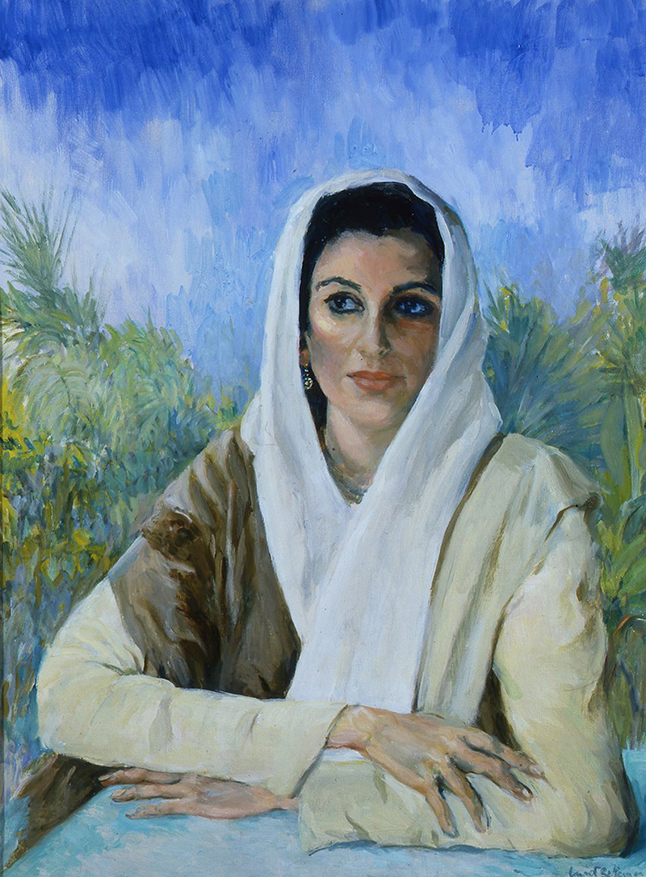
Benazir Bhutto C’1973
Prime Minister of Pakistan and Stateswoman
Benazir Bhutto was born in Karachi, Pakistan in 1953 to an upper class, landowning family. Her father, Zuleika Ali Bhutto, founded the Pakistan People’s Party (PPP) and was prime minister from 1971 to 1977. Educated at private schools in Pakistan, Benazir Bhutto entered Harvard in 1969, at age 16 and received her BA in comparative government in 1973. It was at Harvard that her focus shifted from psychology to government: her senior thesis was on the origins of Pakistan. Subsequently she studied for a second undergraduate degree at Lady Margaret Hall, Oxford University, where she completed a course in International Law and Diplomacy. Upon the death of her father in 1979, she took over the leadership of the PPP, and became the prime minister of a coalition government in 1988-1990. She was the first-ever female prime minister of a Muslim nation. Defeated in elections of 1990, she served a second term from 1993-1996.
Bhutto spent the next ten years exiled in Britain and Dubai, leading her party in absentia. She returned to Pakistan in 2007 to campaign again for prime minister. Having survived one assassination attempt in October, in December 2007 she was killed at another political rally. Her controversial political career still divides Pakistanis, although it is incontrovertible that her achievement was a remarkable one, given the male-dominated environment of late-20th century Pakistani society. In an interview in 1998 with the Crimson, Bhutto said that Harvard was “the very basis of my belief in democracy.”
Doris Hope Lurot Betjeman (1915-2012)
Doris Hope Lurot Betjeman was born in Paris, and attended art school in Dusseldorf and then at the Ecole nationale Superieure des Beaux-Arts in Paris. After her first solo exhibition in 1937, she was commissioned by the British Embassy in Paris to paint a portrait of Sir Robert Cahill, the Commercial Councillor to the Embassy. Many additional portraits followed, including that of her cousin, John Betjeman, the Poet Laureate of the United Kingdom, and Don Jaime, Duke of Segovia and the son of the King of Spain. She moved to London in 1960 and continued painting portraits and landscapes until her death at age 96 in 2012. Lady Margaret Hall, Oxford University, commissioned this portrait of their graduate, Benazir Bhutto.
Oil on canvas, 2009
HCNY copy courtesy of the artist’s estate
Lobby
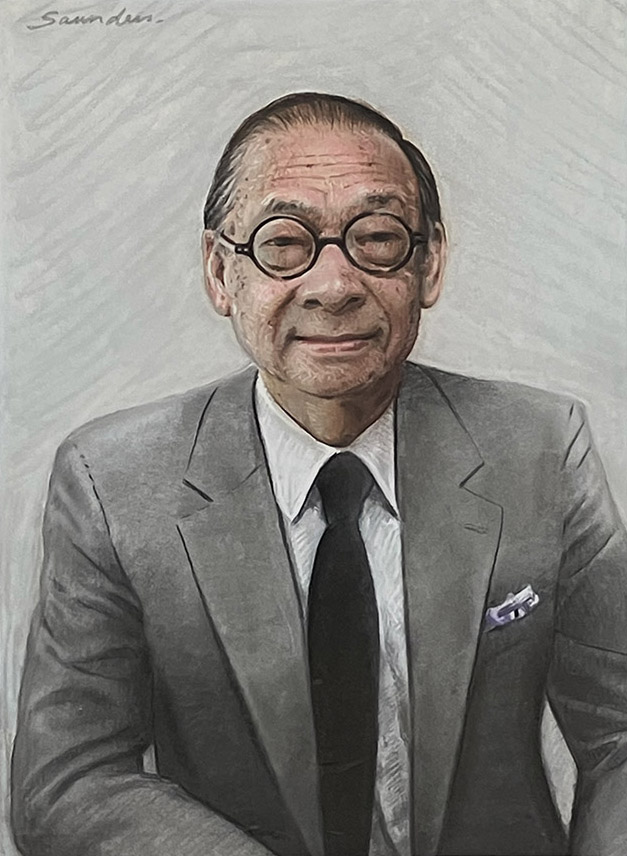
I. M. Pei M’Arch ’1946
Architect
Ieoh Ming Pei was born in Guangzhou, China in 1917. He earned a bachelor of architecture degree from M.I.T. in 1940 and a graduate degree from the Harvard Graduate School of Design in 1946, studying with Walter Gropius, who declared that Pei’s was the best student work to come out of the GSD during his time at the school.
Starting in 1948, he worked in New York City for commercial real estate developer William Zeckendorf, designing large-scale city projects, and by 1960 he had established I.M. Pei & Associates as an independent firm. His signature concrete poured-in-place facades are to be seen at Kips Bay Plaza (1963) and the Silver Towers at N.Y.U. (1967). In 1964 he was chosen by Jacqueline Kennedy for the John F. Kennedy Library in Boston (completed 1979). Other iconic work includes the East Building of the National Gallery in Washington D.C. (1978) and the glass pyramid entrance to the Louvre in Paris (1989). These major projects express his sense of history and tradition in their role in modernism, his use of space and light, and the relationship between architecture and its environment. In 1983, he was the prizewinner of the Pritzker Prize, the highest honor a living architect can receive.
I.M. Pei died in 2019 at age 102 in New York City.
David Saunders (b. 1954)
A native New Yorker, Saunders began his artistic studies at the High School of Music & Art. He graduated from the Kansas City Art Institute in 1975 and afterwards exhibited in New York City art galleries in several solo shows. His first one-man museum show was in 1979 at the New Museum: his works are in the collections of (among others) the Metropolitan Museum of Art and the Museum of Modern Art. He has taught at Yale, Oberlin, and Washington University. In 1987 Mayor Ed Koch presented Saunders with NYC’s Award For Excellence in Design.
Harvard Hall
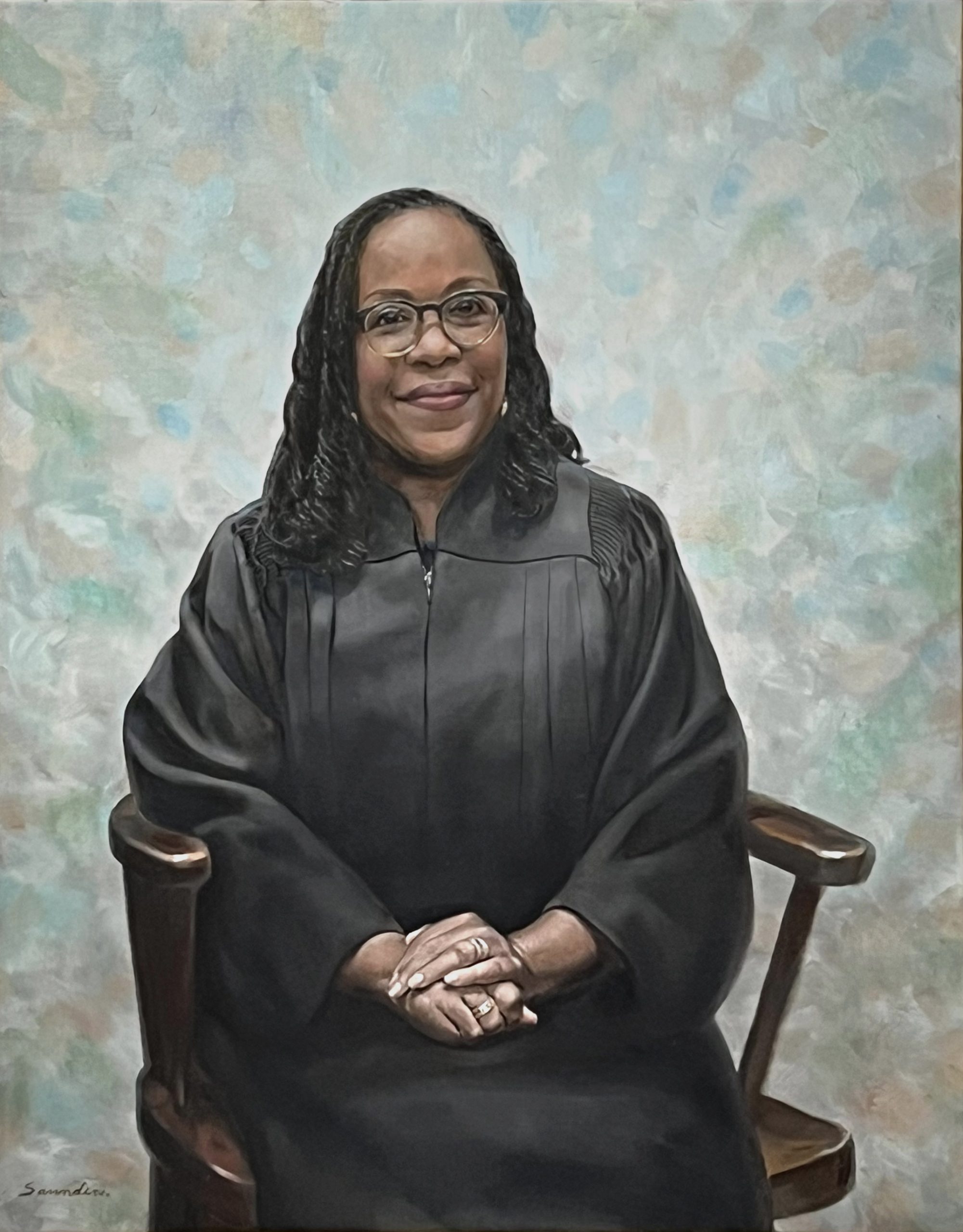
Ketanji Brown Jackson C’1992, L’1996
Associate Justice of the U.S. Supreme Court
Ketanji Brown Jackson was born in Washington D.C in 1970, and raised in Miami, Florida. She attended Harvard College and Law School, where she was a supervising editor of the Harvard Law Review. She began her legal career with three clerkships including one with Associate Justice of the Supreme Court, Stephen Breyer. She worked as an assistant federal public defender in Washington D.C. from 2005-2007, and from 2010-2014 was the vice-chair of the United States Sentencing Commission. In 2012 President Obama nominated her to the U.S. District Court for the District of Columbia where she served from 2013-2021. In 2022 President Biden nominated her to the U.S. Supreme Court, where she succeeded Justice Breyer, and became the first Black woman and former public defender to be appointed to the highest court of the United States.
David Saunders (b. 1954)
A native New Yorker, Saunders studied at the High School of Music & Art. He graduated from the Kansas City Art Institute in 1975 and afterwards exhibited in NYC art galleries in various solo shows. His first one-man museum show was in 1979 at the New Museum. His works are in the collections of the Metropolitan Museum of Art and the Museum of Modern Art, among others. He has taught at Yale, Oberlin, and Washington University. In 1987 Mayor Ed Koch presented Saunders with NYC’s Award For Excellence in Design. The artist’s wife, Mary Saunders is curator of the HCNY and it is in her honor that this painting is donated to the Club.
Oil on canvas, 2022
Harvard Hall
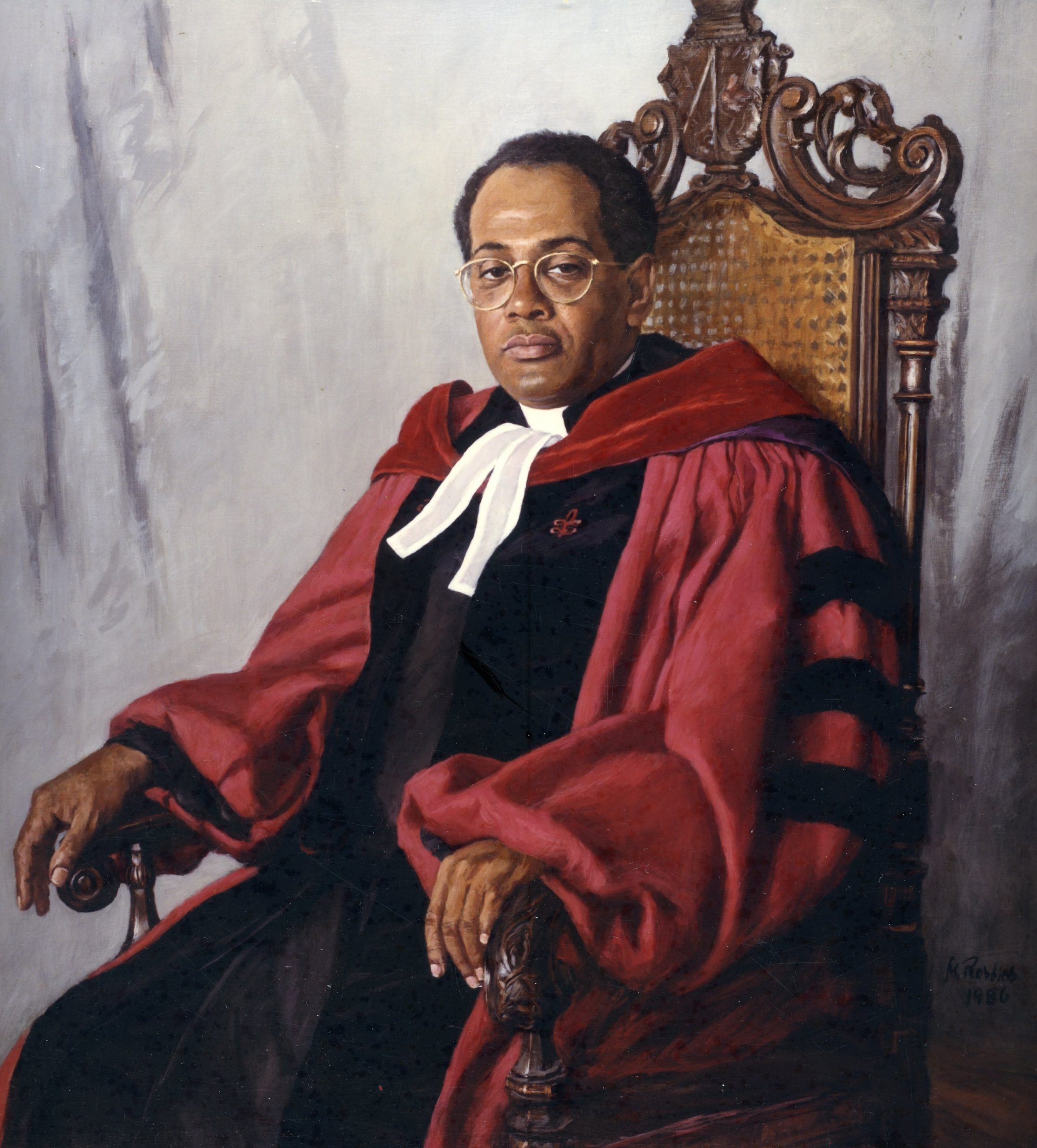
Peter John Gomes Dv’1968
Pusey Minister Memorial Church 1970-2011
Peter Gomes (1942-2011) was born in Plymouth Massachusetts, and after his undergraduate studies at Bates College, (BA 1965) he entered the Divinity School at Harvard (Dv’1968). He then spent two years at the Tuskegee Institute teaching history after which he returned to Harvard in 1970 as the Plummer Professor of Christian Morals and Pusey Minister in the Memorial Church, titles he held to the end of his life. A masterful orator at Harvard commencement ceremonies, he was the speaker twice at Harvard Club of New York Annual Dinners. He was an outspoken proponent of gay rights, and a leading voice against religious intolerance; he received many honors internationally. Gomes preached and lectured widely across the United States and the British Isles, and was the author of numerous books and articles.
Melvin Robbins (1918-1999)
A graduate of Boston University in 1939 and the Massachusetts Art School, Robbins devoted his career to painting portraits of prominent people in the Boston area. He painted five portraits for Harvard’s collection of prominent faculty including this one of Gomes. The original is displayed in Memorial Church and was a gift in 1987 from the Reverend’s friends to honor his contribution to the church and the college.
Oil on canvas, 1986
HCNY copy courtesy of the artist’s estate
Bar Lounge
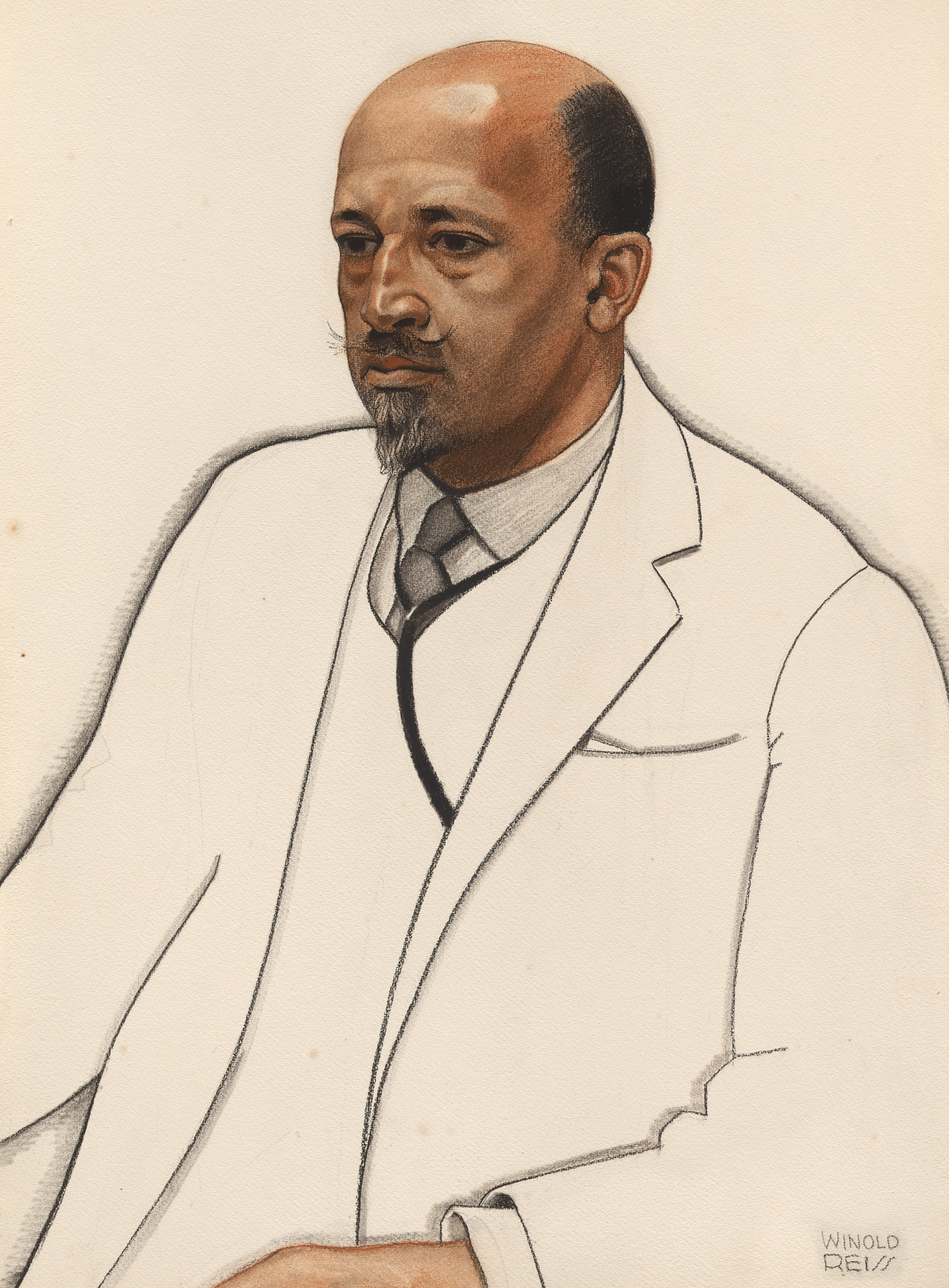
W.E.B. Du Bois C’1890, M’1891, PhD’1895
Sociologist, historian, civil rights activist
William Edward Burghardt Du Bois (1868-1963) was born in Great Barrington, Massachusetts and attended Fisk University for a BA (1888). He entered Harvard as a junior and received a second BA in 1890. In 1895 he became the first Black American to receive a PhD from Harvard, after which he lectured and taught widely, and was appointed professor of history, sociology and economics at Atlanta University. He is well known as a founder of the NAACP. A prolific author, as well as a pan-Africanist, his book The Souls of Black Folk is a seminal work in African American literature. He died in Accra, Ghana in 1963. Harvard’s highest honor in the field of African and African American Studies is named for Dr. Du Bois.
Winold Reiss (1886-1953)
Born in Karlsruhe, Germany, Reiss immigrated to the United States in 1913. By 1915 he was lecturing at the Art Students League and in 1922 he opened an art school of his own. A graphic designer, he was noted for his interior designs for restaurants and hotels. In 1925 he illustrated Alain Locke’s historic anthology, “The New Negro,” about the celebrities of the Harlem Renaissance, and this portrait of Dr. Du Bois was created for that publication. The original portrait is in the collection of the National Portrait Gallery in Washington D.C.
Pastel on paper, 1925
HNCY copy courtesy of the artist’s estate
Bar Lounge
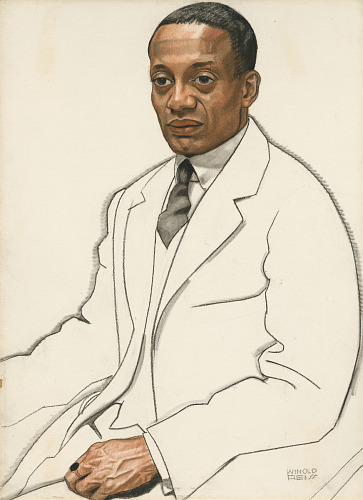
Alain LeRoy Locke C’1908, PhD. 1918
Philosopher, writer, educator
Alain Locke was born in 1885 in Philadelphia to a family of educators and prominent civil servants. He graduated with high honors from Harvard in 1907 after three years and his focus was philosophy. Elected to Phi Beta Kappa, he was also the recipient of the Bowdoin prize. He was the first Black student to win the Rhodes Scholarship and studied two years at Oxford University where he continued his studies in philosophy and afterwards continued at the University of Berlin. He returned to Harvard for one year to finish his Ph.D. in 1918 the third Black American to do so. For over thirty years he taught philosophy at Howard University in Washington, D.C., and in 1921, he became the dean of the department, influencing generations of students. He provided the philosophical basis for the New Negro Movement and the Harlem Renaissance. Having studied African culture, he encouraged Black artists to look for African sources for identity, and he urged Black authors to seek subjects in Black life.
Locke was an early and powerful advocate that Black culture was not separate from American culture, but a crucial part of it. In 1925, he published his seminal book, “The New Negro.” It was an anthology of fiction, poetry and writings about music, art and literature by him and other Black writers. This book connects his aesthetic interests philosophically and practically to his interest in democracy, racial equality and the theory of value. For his prominent role in articulating the intellectual scope of this period, Locke earned the title “Dean of the Harlem Renaissance.” His legacy sparks a reoccurring interest in examining African culture and art. Alain Locke died in New York City in 1954.
Winold Reiss (1886-1953)
Born in Karlsruhe, Germany, Reiss immigrated to the United States in 1913. By 1915 he was lecturing at the Art Students League and in 1922 he opened an art school of his own. A graphic designer, he was noted for his interior designs for restaurants and hotels. In 1925 he illustrated Alain Locke’s historic anthology of writers and artists of the Harlem Renaissance, “The New Negro,”. This portrait of Dr. Locke and that of Dr. Du Bois were created for that publication. The original portraits are in the collection of the National Portrait Gallery in Washington D.C.
Pastel on paper, 1925
HCNY copy courtesy of the artist’s estate
Main Bar
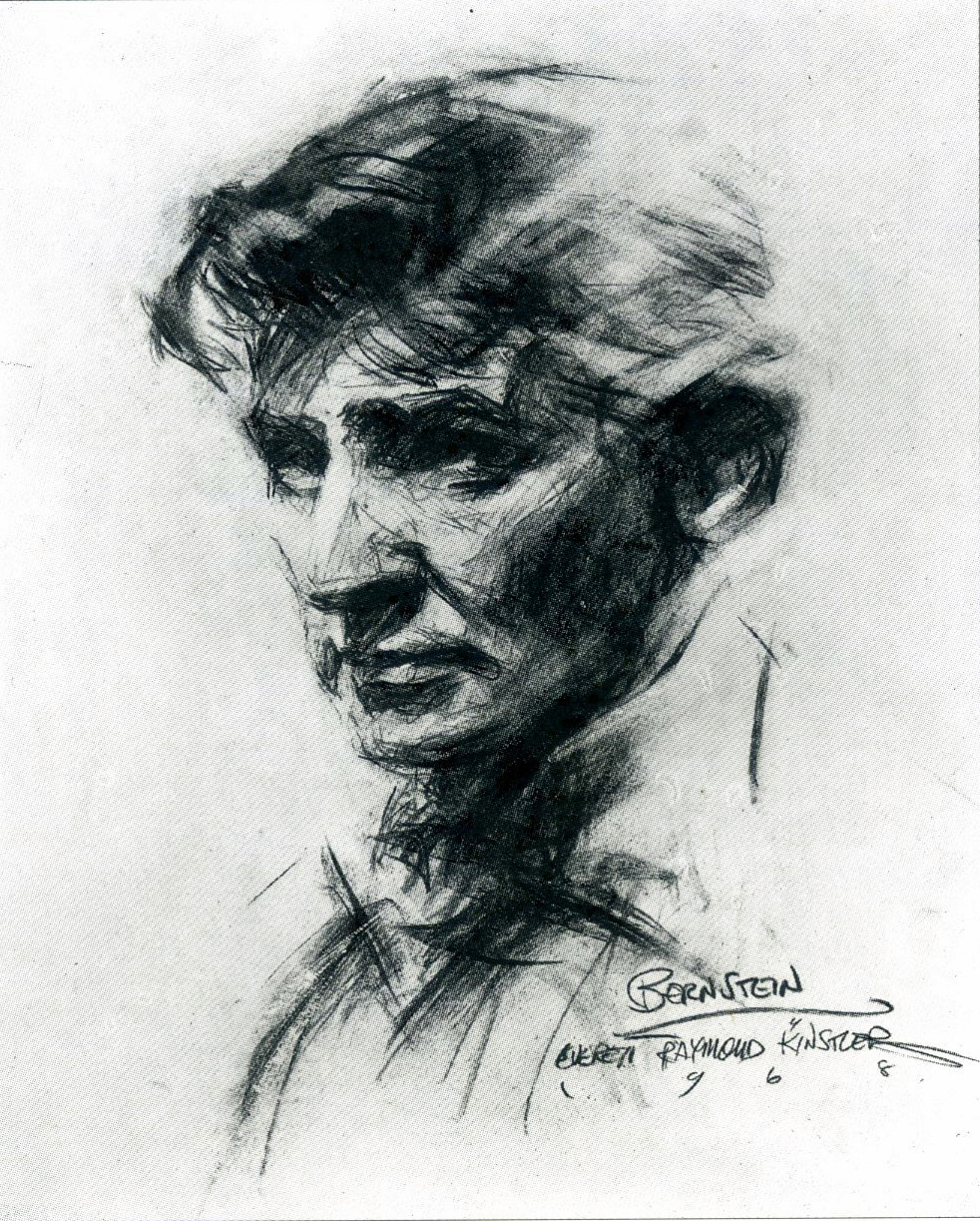
Leonard Bernstein C’1939, Hon’1967
Conductor & Composer
Leonard Bernstein (1918-1990) grew up in Lawrence, Massachusetts and in 1935 entered Harvard which nurtured his relentless intellectual curiosity as much as his musical talents. He was involved with music on campus in many ways– playing piano for the Glee Club, accompanying silent movies in Sanders Theater, and composing and directing the score for a Greek play. His senior thesis was “The Absorption of Race Elements into American Music.” Achieving celebrity quite early, he maintained ties to Harvard throughout his life. In 1957, collaborating with lyricist Alan Jay Lerner C’1940, Bernstein composed two pieces called “Songs of Harvard,” to premiere at the joint Band-Glee Club Carnegie Hall concert. He was the music director of the New York Philharmonic from 1957-1969. A dynamic composer and conductor, he brought progressive innovations to the world of classical music. In 1973, he accepted a yearlong post as Charles Eliot Norton Professor of Poetry and gave six lectures over the year. The series entitled “The Unanswered Question,” addressed the long-running debate about the twelve-tone technique’s value to music in an interdisciplinary fashion. Bernstein was made an honorary member of the Harvard singing group Krokodiloes in 1980 and in 1986 hosted the Kroks at Carnegie Hall.
Everett Raymond Kinstler (1926-2019)
A native New Yorker, Kinstler began his career doing illustrations for popular magazines. He studied at the Art Students League where he later taught from 1969-1974. His exceptional skill as a portrait painter established him as one of the nation’s most highly regarded artists. Besides U.S. Presidents, Supreme Court Justices, Cabinet members and well-known personalities, Kinstler has painted three Harvard presidents and eleven portraits for the Harvard Club, including that of Helen Keller. His original portrait of Bernstein is in the collection of the National Arts Club, New York.
Charcoal on paper, 1968
HCNY copy courtesy of the artist’s estate
Main Bar
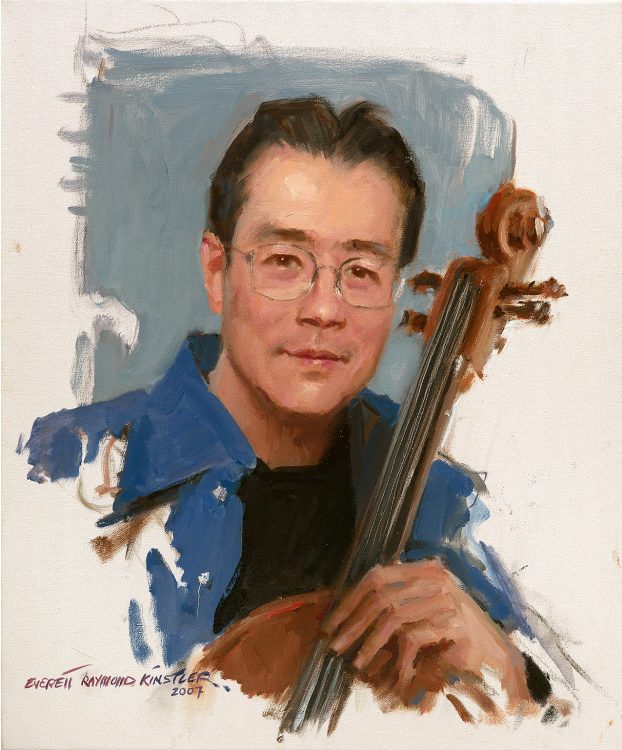
Yo Yo Ma C’1976, Hon’1991
Cellist & Humanitarian
Yo Yo Ma was born in Paris in 1955, and educated there and in New York City. A child prodigy at the cello, he was performing professionally from the age of five. After studies at Juilliard he entered Harvard in 1972 and finished with a degree in anthropology in 1976. His honors include the Presidential Medal of Freedom in 2011, awarded by President Barack Obama for his contribution to the arts. In addition to being the most acclaimed cellist of our time, he is hailed as a person of unquestionable character and generosity of spirit. Ma has incorporated the goals of social justice and peace into his musical work, crediting Harvard for introducing him to different worlds and different ways of thinking. It was there, he said, that “I learned how science and art are joined under philosophy. Harvard got me going on all kinds of searches.”
Everett Raymond Kinstler (1926-2019)
A native New Yorker, Kinstler began his career doing illustrations for popular magazines. He studied at the Art Students League where he later taught from 1969-1974. His exceptional skill as a portrait painter established him as one of the nation’s most highly regarded artists. Besides U.S. Presidents, Supreme Court Justices, Cabinet members and well-known personalities, Kinstler has painted three Harvard presidents and eleven portraits for the Harvard Club, including that of Helen Keller. His original portrait of Ma is in the collection of the National Portrait Gallery, Washington D.C.
Oil on canvas, 2007
HCNY copy courtesy of the artist’s estate